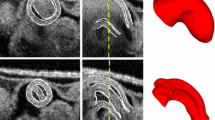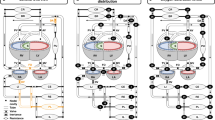Abstract
During human gestation, fetal body size increases considerably and important transformations occur to hemodynamics of the cardiovascular system of the fetus. Vascular compliances and resistances as well as the cardiac function show important changes. In order to investigate these modifications, a mathematical approach based on scaling techniques was developed. Vascular and cardiac parameters of the human fetus were related by allometric equations to the anatomical dimensions of vessels that, in turn, depend on the fetal body weight and the gestational age. A scaling factor (b) was identified for each parameter under study: vascular resistances and flow inertances decrease with gestational age b=--1 for viscous losses and b=--1.33 for convective dissipations, b=--0.33 for flow inertances) whereas vascular compliances remarkably increase (b=1.33). Scaling factors were also adopted for the fetal cardiac parameters, according to experimental data on the development of fetal myocardium. Parameter values calculated for each week of the last trimester of the fetal gestation, were tested using a mathematical lumped parameter model, previously developed for a human fetus near the term of the gestation. The validation of the scaling method adopted for the parameters was performed by comparing the results of the simulations with a group of data obtained by Doppler velocimetry at different stages of fetal normal gestation. The adopted allometric equations were appropriate in describing the development of the human fetal circulatory system. The ductus venosus, the ductus arteriosus, and the foramen ovale, that conclude their function at the birth moment, as well as the lungs and the brain, do not follow the general growth rate and require different scaling factors. © 2000 Biomedical Engineering Society.
PAC00: 8719Uv, 8719Hh, 8710+e
Similar content being viewed by others
REFERENCES
1_ Alvarez, L., A. Aranega, R. Saucedop, and J. A. Contreras. The quantitative anatomy of the normal human heart in fetal and perinatal life. Int. J. Cardiol.17:57-72, 1987.
2_ Avanzolini, G., P. Barbini, A. Cappello, and A. Cevese. Time-varying mechanical properties of the left ventricle. A computer simulation. IEEE Trans. Biomed. Eng.32(10):756-763, 1985.
3_ Bellotti, M. Echographic measurement of the human fetal venous system. (Personal communication, 1998).
4_ Biagiotti, R., L. Brizzi, E. Cariati, A. S. Puliga, and R. Nannini. The use of Rossavik's mathematical model in determining individual intrauterine growth curves. Our experience. Minerva Ginecol.46(3):81-84, 1984.
5_ Brezinska, C., T. W. Huisman, T. Stijnen, and J. W. Wladimiroff. Normal Doppler flow velocity waveforms in the fetal ductus arteriosus in the first half of pregnancy. Ultrasound Obstet. Gynecol.2:397-401, 1992.
6_ De Smedt, M. C. H., G. H. A. Visser, and E. J. Mejiboom. Fetal cardiac output estimated by Doppler echocardiography during mide and late gestation. Am. J. Cardiol.60:338-342, 1987.
7_ De Vore, G. R., and J. Horenstein. Ductus venosus index: a method for evaluating right ventricular preload in the second-trimester fetus. Ultrasound Obstet. Ginecol.3:338-342, 1993.
8_ Feit, L. R., J. A. Copel, and C. S. Kleinman. Foramen ovale size in the normal and abnormal human fetal heart: an indicator of transatrial flow physiology. Ultrasound Obstet. Gynecol.1:313-319, 1991.
9_ Ferrazzi, E., P. Gementi, M. Bellotti, M. Rodolfi, S. Della Peruta, A. Barbera, and G. Pardi. Doppler velocimetry: critical analysis of umbilical, cerebral and aortic reference values. Eur. J. Obstet. Gynecol. Reprod. Biol.38:189-196, 1990.
10_ Friedman, W. F.The intrinsic properties of the developing heart. Prog. Cardiovasc. Dis.15(1):87-111, 1972.
11_ Gallivan, S., S. C. Robson, T. C. Chang, J. Vaughan, and J. A. D. Spencer. An investigation of fetal growth using serial ultrasound data. Ultrasound Obstet. Gynecol.3:109-114, 1993.
12_ Guettouche, A., J. C. Challier, Y. Ito, C. Papapanayotou, Y. Cherruault, and A. Azancot-Benisty. Mathematical modeling of the human fetal arterial blood circulation. Int. J. Bio-Med. Comput.31:127-139, 1992.
13_ Guettouche, A., J. C. Challier, Y. Ito, C. Papapanayotou, Y. Cherruault, and A. Azancot-Benisty. Optimization and resolution algorithm of the human fetal blood circulation model. Math. Comput. Modelling18(9):1-8, 1993.
14_ Hecher, K., S. Campbell, R. Snijders, and K. Nicolaides. Reference ranges for fetal venous and atrioventricular blood flow parameters. Ultrasound Obstet. Gynecol.4:381-390, 1994.
15_ Holt, J. P., E. A. Rhode, W. W. Holt, and H. Kines. Geometric similarity of aorta, venae cavae, and certain of their branches in mammals. Am. J. Physiol.10(1):R100-R104, 1981.
16_ Hornberger, L. K., R. G. Weintraub, E. Pesonen, A. Murillo-Olivas, I. A. Simpson, C. Sahn, S. Hagen-Ansert, and D. J. Sahn. Echocardiographic study of the morphology and growth of the aortic arch in the human fetus. Observations related to the prenatal diagnosis of coarctation. Circulation86(2):741-747, 1992.
17_ Huhta, J. C., K. J. Moise, D. J. Fisher, D. S. Sharif, N. Wasserstrum, and C. Martin. Detection and quantitation of constriction of the fetal ductus arteriosus by Doppler echocardiography. Circulation75(2):406-412, 1987.
18_ Iberall, A. S.Growth, form, and function in mammals. Ann. (N.Y.) Acad. Sci.231:77-84, 1974.
19_ Kenny, J. F., T. Plappert, P. Doubilet, D. H. Saltzman, M. Cartier, L. Zollars, G. F. Leatherman, and M. St. John Sutton. Changes in intracardiac blood flow velocities and right and left ventricular stroke volumes with gestational age in the normal human fetus: A prospective Doppler echocardiographic study. Circulation74(6):1208-1216, 1986.
20_ Kiserud, T., S. H. Eik-Nes, H. G. Blaas, L. R. Hellevik, and B. A. Angelsen. Estimation of the pressure gradient across the fetal ductus venosus based on Doppler velocimetry. Ultrasound Med. Biol.20:225-232, 1994.
21_ Kiserud, T., S. H. Eik-Nes, H. G. Blaas, and L. R. Hellevik. Ductus venosus, a longitudinal Doppler velocimetric study of the human fetus. J. Matern. Fetal Invest.2:5-11, 1992.
22_ Luecke, R. H., W. D. Wosilait, and J. F. Young. Mathematical representation of organ growth in the human embryo/fetus. Int. J. Bio-Med. Comput.39:337-347, 1995.
23_ Manabe, A., T. Hata, D. Senoh, K. Hata, and M. Kitao. Mathematical modeling of fetal organ growth using the Rossavik growth model: III. Cardiac ventricle. Am. J. Perinatol.11(5):320-325, 1994.
24_ Marshall, S. A., and A. E. Weyman, “Doppler estimation of volumetric flow, ” In: Principles and Practice of Echocardiography, edited by A. E. Weyman. Philadelphia. Lea & Febiger, 1994, pp. 955–977.
25_ Mc Donald, D. A., W. W. Nichols, and M. F. O'Rourke, Blood Flow in Arteries. Theoretic, Experimental and Clinical Principles. 3rd ed., London, Edward Arnold, 1990, pp. 125–142.
26_ Milnor, W. R. “Comparative hemodynamics: the influence of body size. ” In: Hemodynamics, edited by W. R. Milnor. Baltimore, Williams & Wilkins, 1982, pp. 161–166.
27_ Pennati, G., Mathematical modelling of the fetal cardiovascular system. Ph.D. Thesis, Politecnico di Milano, 1995. (italian)
28_ Pennati, G., M. Bellotti, and R. Fumero. Mathematical modelling of the human fetal cardiovascular system based on Doppler ultrasound data. Med. Eng. Phys.19(4):327-335, 1997.
29_ Rasanen, J., D. C. Wood, S. Weiner, A. Ludomirski, and J. C. Hutha. Role of the pulmonary circulation in the distribution of human fetal cardiac output during the second half of pregnancy. Circulation94(5):1068-1073, 1996.
30_ Rideout, V. C.Cardiovascular system simulation in Biomedical Engineering Education. IEEE Trans. Biomed. Eng.19(2):101-107, 1972.
31_ Romero, T., J. Covell, and W. F. Friedman. A comparison of pressure-volume relations of the fetal, newborn, and adult heart. Am. J. Physiol.222(5):1285-1290, 1972.
32_ Sharland, G. K., and L. D. Allan. Normal fetal cardiac measurements derived by cross-sectional echocardiography. Ultrasound Obstet. Gynecol.2:175-181, 1992.
33_ Thornburg, L. T., and M. J. Morton. “Development of the cardiovascular system.” In Textbook of Fetal Physiology, edited by D. G. Thornburg and R. Harding, Oxford, Oxford University Press, 1994, pp. 95–130.
34_ Tulzer, G., S. Gudmundsson, A. M. Sharkey, D. C. Wood, A. W. Cohen, and J. C. Huhta. Doppler echocardiography of fetal ductus arteriosus constriction versus increased right ventricular output. J. Am. Coll. Cardiol.18(2):532-536, 1991.
35_ West, G. B., J. H. Brown, and J. B. Enquist. A general model for the origin of allometric scaling laws in biology. Science276:122-126, 1997.
36_ Westerhof, N., F. Bosman, C. De Vries, and A. Noordergraaf. Analog studies of the human systemic arterial tree. J. Biomech.5:121-143, 1969.
37_ Yellin, E. L., C. S. Peskin, and R. W. M. Frater. Pulsatile flow across the mitral valve: hydraulic, electronic and digital computer simulation. ASME72-WA BHF-10, 1972.
38_ Zimmermann, R., K. H. Eichorn, A. Huch, and R. Huch. Doppler ultrasound examination of fetal renal arteries. Ultrasound Obstet. Gynecol.2:420-423, 1992.
Author information
Authors and Affiliations
Rights and permissions
About this article
Cite this article
Pennati, G., Fumero, R. Scaling Approach to Study the Changes Through the Gestation of Human Fetal Cardiac and Circulatory Behaviors. Annals of Biomedical Engineering 28, 442–452 (2000). https://doi.org/10.1114/1.282
Issue Date:
DOI: https://doi.org/10.1114/1.282




